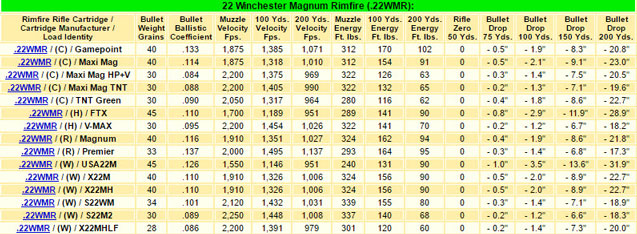.22 WMR Ballistics Chart
by Chris Nelson
This .22 WMR Ballistics Chart provides details on the ballistic coefficient, muzzle energy, muzzle velocity, and bullet drop for 15 renowned .22 WMR rimfire cartridges. Manufacturers are abbreviated as follows: (C) for CCI; (H) for Hornady; (R) for Remington; and (W) for Winchester.

Comparison of Hornady V-MAX .22 WMR Ballistics to Winchester S22M2 .22 WMR Ballistics:
- Bullet Weight: Measured in grains, with 7,000 grains equaling one pound and 437.5 grains in one ounce. The Hornady V-MAX and Winchester S22M2 Ammunition both weigh 30 grains, or .06 ounces.
- Ballistics Coefficient (BC): This is the bullet's drag factor in decimal form. A higher number suggests less drag. The Hornady V-MAX Ammo's BC is .095, while the Winchester S22M2 Bullet's BC is .101.
- Muzzle Velocity: This denotes the bullet's speed as it exits the barrel, measured in FPS. Generally, a faster muzzle velocity results in a flatter trajectory. The Hornady V-MAX Ammo has a velocity of 2,200 fps, compared to the Winchester S22M2's 2,250 fps.
- Muzzle Energy: This is the bullet's potential damage upon exiting the muzzle, measured in foot-pounds. The Winchester S22M2 has a higher muzzle energy than the Hornady V-MAX at every distance.
- Bullet Drop Chart: This tool compares the bullet drop trajectories of Hornady, CCI, Remington, and Winchester .22 WMR cartridges at various distances.